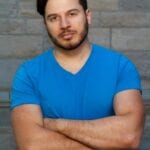The Summerworks Festival is more than half-done, but there’s still plenty of time to catch some innovative and compelling pieces of theatre. One of the most fascinating shows at the festival is The Middle Place, by Toronto-based gay actor and playwright Andrew Kushnir. The Middle Place is a beautifully constructed and performed work of verbatim theatre, composed entirely out of interviews Kushnir did with the residents and workers at a Rexdale youth shelter. Kushnir is also the creative director of Project: Humanity, a local not-for-profit raising awareness through the arts with a strong emphasis on community service. I spoke with Kushnir about being a gay man creating a work for and about Rexdale youth.
Rob Salerno: Where did your interest in Rexdale youth come from?
Andrew Kushnir: Rexdale is a tough neighbourhood – one of the toughest in the GTA – and the prospect of meeting with homeless youth from a tough neighbourhood terrified me. And yet I knew that this was a community in need. A community that needed to feel heard. It bothered me that fear could be an obstacle to doing something good. So that tension urged me to go “I need to figure that out, to listen harder, to actually meet these people I’m scared of.” So my interest was initiated by a fear. But once I started to meet with them, my interest found a completely different source. With every youth I met, I was struck by how irrational my fear had been. These youth are incredible, familiar human beings. I call it the non-epiphany of the play, but had one or two things happened differently in my life, I could have been in their shoes.
RS: Some gays in Toronto would be shocked to hear that a white gay man went to go spend time with at-risk youth in Rexdale. Did you find the Rexdale community accepting?
AK: I met nothing but acceptance from that community. Frankly, my identity was a real non-issue in this environment. The youth caught in this “middle place,” this place between homes, have so much more to worry about than the orientation of the people trying to help them. This particular shelter prides itself on having a really broad demographic. The youth are between the ages of 16-24. They are representative of all levels of socio-economic status, ethnicity, gender, religion and sexual orientation. I never encountered an out resident in any of my interviews, but I know for a fact that there have been gay residents that have stayed there.
RS: Why was verbatim theatre the form you chose for this piece? What does this format allow that documentary or straight drama wouldn’t?
AK: The thing that makes verbatim theatre the ideal choice for this portrait of a community is its built-in anonymity. The vast majority of shelter youth don’t want people knowing they’re in a shelter. This medium affords them an opportunity to give voice to an experience that they would otherwise keep to and between themselves. Verbatim theatre is so inherently human — and there’s something so potent about a piece of art that activates both the imagination and the conscience. We don’t need to use our imaginations much when we watch a documentary and we’re not necessarily rendered socially-aware by a straight drama. Verbatim theatre has a real tension, a tug-of-war between the two. These are real words from real people, and yet we experience them through actors. And it’s been so satisfying seeing audiences at SummerWorks struggle between the beauty and entertaining side of the form (and these amazing and often funny youth and caseworkers) and then the “Wow, someone actually said that” element. Especially when that “someone” is a someone from our very own community. I can’t tell you how many people have emailed me over the past week saying “I keep thinking about those youth.” The form will do that to you, it haunts you after.
RS: You’re as much a character in the show as the staff and youth at the shelter. What’s it like to see yourself played on stage? Did you work much with (actor) Paul Dunn on crafting the unnamed “Andrew” character?
AK: Only in the last draft of this play was the Outsider character isolated. In earlier versions of the play there were four actors who generated the leading questions themselves. But the longer I worked on it, the more apparent it was to me that this is a deeply personal piece of writing and that I can’t take myself out of it. To take myself out of it would be inaccurate and irresponsible. I don’t want audiences to forget that an artist has chosen to show what he wanted to show. I want audiences to see that the questioner is not some kind of god but a very human, flawed, at-times-nervous presence. If there is a story to this play, it’s that of an outsider discovering a community he didn’t know. What were the highlights of that journey for him? Which arias stuck out? And through the intimate act of listening, the unnamed “Andrew” character develops a feeling of sameness with “the other.” And that isn’t journalism. That is my construct. I have a much deeper understanding of the piece (and frankly, myself) having heard Paul re-enact my part in it. Paul has done an extraordinary job of honouring the arc of the Outsider. He’s done an incredible job of guiding the audience’s journey through the piece. And given that he’s such a good friend of mine (and such a good actor), he knows how to pack my short questions with lots of nuance and meaning.
The Middle Place plays at Theatre Passe Muraille Saturday at 10:30pm.
I’m also catching another queer-themed play, My Funny Valentine, in the Passe Muraille Backspace, which plays tonight at 10pm, Saturday at 6pm, and Sunday at noon.

 Why you can trust Xtra
Why you can trust Xtra


